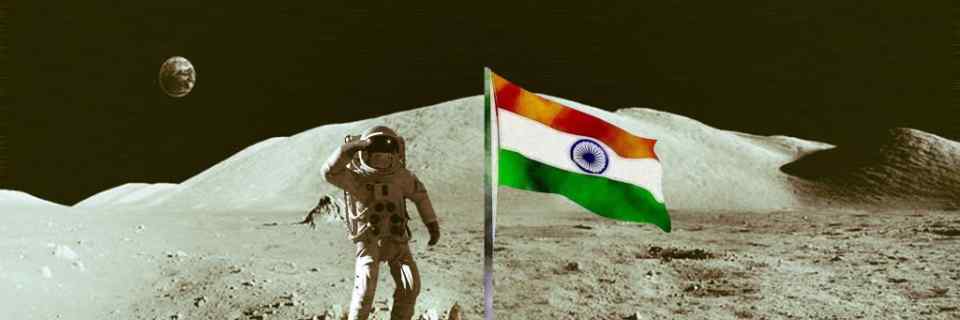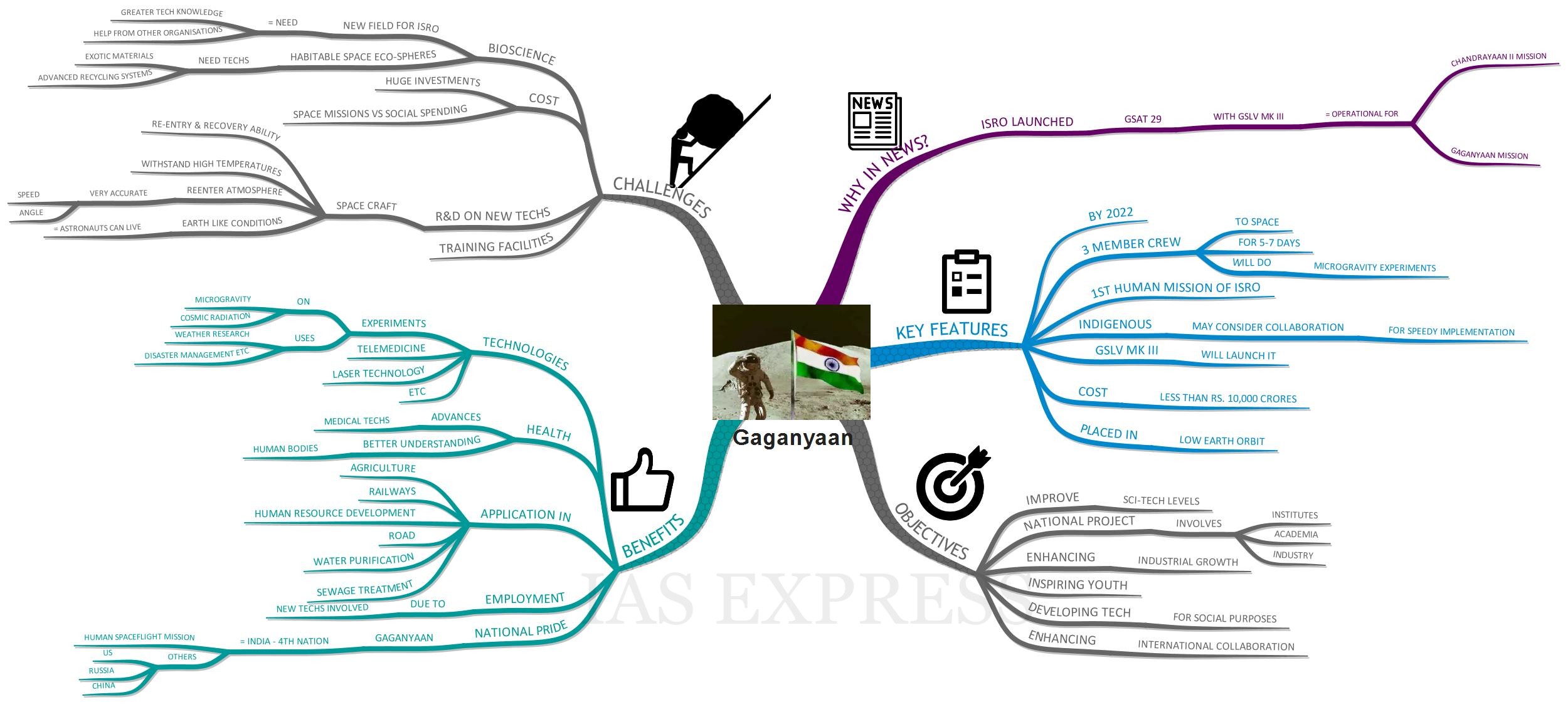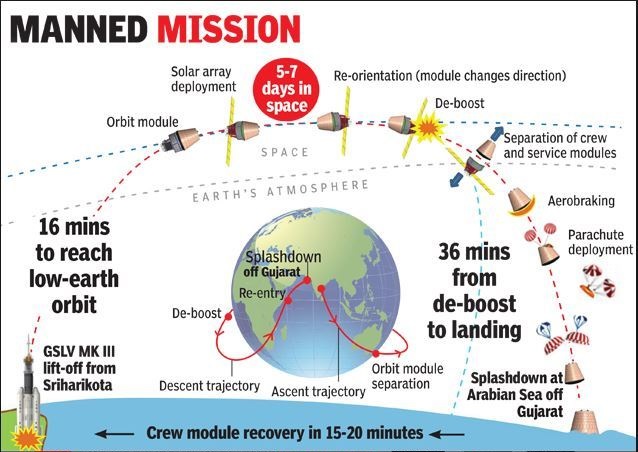Gaganyaan Mission – India’s Quest towards putting Indians in Space

From Current Affairs Notes for UPSC » Editorials & In-depths » This topic
IAS EXPRESS Vs UPSC Prelims 2024: 85+ questions reflected
ISRO has launched GSAT-29 communication satellite successfully on board GSLV-MK III D2. With this launch, GSLV-MK III is considered to be operational for space missions like Chandrayaan II and Gaganyaan. Gaganyaan mission was announced by Prime Minister in his Independence Day speech, that ISRO will be sending its first human spaceflight mission into space by 2022.
What are the key features of the mission?
- It aims at sending 3 member crew to space for 5 to 7 days. The crew will do microgravity experiment during the mission.
- It is the first human mission indigenously developed by ISRO. However, to accelerate the pace of the programme, ISRO may consider collaborations with space agencies from friendly countries. Already, France and Russia have committed full support to this mission.
- GSLV MK-III launch vehicle will be used to launch Gaganyaan. (Click here to learn about GSLV MK-III).
- Two unmanned Gaganyaan missions will be launched prior to sending humans.
- The entire programme is expected to be completed by 2022.
- The cost is expected to be less than Rs. 10,000 crores.
- The spacecraft will be placed in a low-earth orbit of 300-400 km. (click here to learn basics).
What are the objectives of the mission?
- Improvement of science and technology levels in the country.
- A national project involving various institutes, academia, and industry.
- Enhancement of Industrial growth.
- Inspiring youth.
- Developing technology for social purposes.
- Enhancing international collaboration.
What are the developments up until now?
- ISRO has successfully demonstrated certain technologies critical for the mission like Space Capsule Recovery Experiment (SRE-2007), Crew module Atmospheric Re-entry Experiment (CARE-2014), GSLV Mk-III, Reusable Launch Vehicle – Technology Demonstrator (RLV-TD) (click here to learn), Crew Escape System (2018) and Pad Abort Test (2018).
- ISRO also recently unveiled a space capsule (crew module) and Space Suit prototype.
- ISRO also finalized the layout and design of Environmental Control & Life Support System (ECLSS) which maintains a steady cabin pressure and air composition, removes CO2 and other harmful gases, controls temperature and humidity, and manages parameters such as fire detection and suppression, food and water management, and emergency support.
What are the benefits of Gaganyaan Mission?
Technologies:
- Many of the current techs were the result of space research.
- Experiments on the effects of microgravity and cosmic radiation have already led to huge advances in various techs ranging from weather research to disaster management to ballpoint pens.
- Telemedicine including miniaturized ultrasound units and remote monitoring systems were developed via space research.
- Moreover, the development of laser and robotic surgery was possible due to the development of better laser technology which is a part of space technology.
Health:
- Manned space missions have already led to advances in medical technologies and the basic understanding of the functioning of human bodies.
- For example, microgravity can result in a loss of muscle and bone density = scientists developed techs and fitness mechanisms that have been breakthroughs in the treatment of osteoporosis and maintaining muscle mass.
Ease of living:
- Space technologies led to ease of living due to its application in various areas such as Agriculture, Railways, Human Resource Development, Road, Transport & Highways, water purification, sewage recycling etc.
- Advanced Astroculture.
- An ethylene removal system.
- developed in space to remove viruses, bacteria, and mould.
- Now it is being used in wine-making and also to increase the shelf life of fruits and vegetables.
- Silica Aerogel – developed by ISRO for space purposes, now being utilized in other fields such as agriculture etc.
Employment:
Manned space research generates much more employment than unmanned missions. ISRO has estimated that Gaganyaan will generate 15,000 jobs because of the new techs involved.
Nation pride:
- Gaganyaan will make India the 4th nation in the world to launch a Human spaceflight mission.
- So far, only the US, Russia and China have launched manned space missions.
What are the challenges to the mission?
Biosciences: ISRO has only perfected the engineering features of the missions, however, bioscience is a new field for ISRO that need greater technical knowledge and support from other organizations. Creating habitable space eco-spheres also need a range of technologies such as exotic materials and advanced recycling systems.
Cost: Manned missions need huge investments. But for a developing nation like India with limited resources, there has always been a debate on the need for costly missions versus spending on the social sector.
R&D on new techs: Manned space programme involves research and development of new techs and there is also a need for precision.
- It involves mastering a highly complicated and dangerous re-entry and recovery ability. The spacecraft requires to withstand very high temperatures, in excess of many thousand degrees while re-entering the atmosphere.
- Furthermore, the spacecraft requires to reenter the atmosphere at a very accurate speed and angle, and even a small deviation could result in a disaster.
- ISRO also needs to build a spacecraft in which astronauts can live in Earth-like conditions in space.
- Elements include systems to maintain the environment, provide food and process waste and deal with emergencies.
Training: India doesn’t have training facilities for astronauts. Even though ISRO has demanded indigenous training centers for its astronauts since the early 2000s, no actions have been taken by the government yet.
Way ahead
It is true that human space flight no longer meant a national prestige, as it did during the cold war (US vs Russia). However, the project would level up our space industry by forcing it to meet challenges beyond the low-cost launch payloads in which ISRO has already excelled. Moreover, certain missions could be better performed by humans than by robots. Also, the technical knowledge created in the process would be of use much later, in ways that may not be obvious today.
If you like this post, please share your feedback in the comments section below so that we will upload more posts like this.



